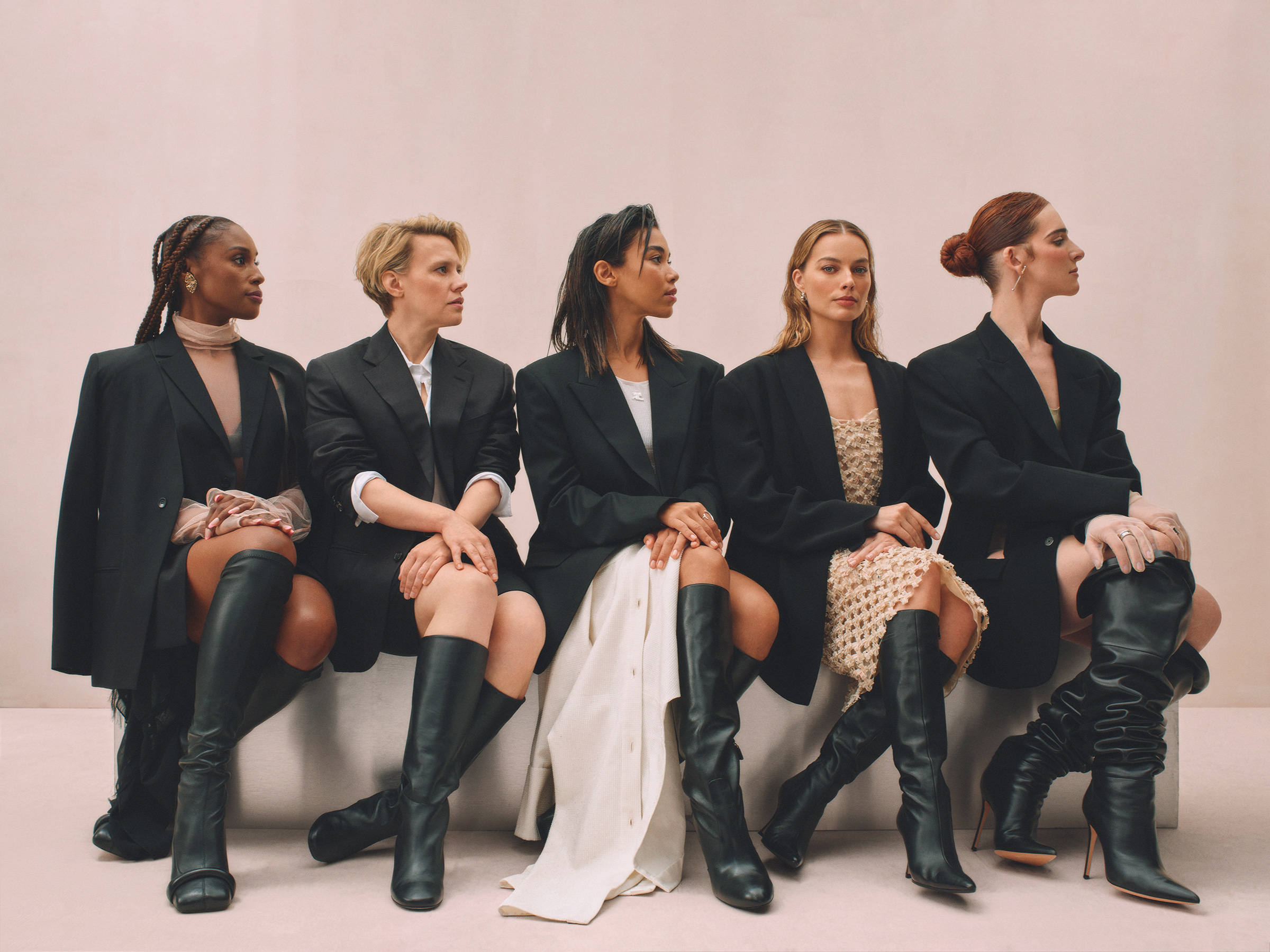There’s plenty to consider about Barbie, but let’s start with her feet. Perfectly arched, but not quite demi-pointe—the ideal position to fit into any pump. They’re instantly recognizable to anyone who has ever played with the iconic doll. So when the trailer for the upcoming live-action Barbie movie opened with a shot of star Margot Robbie stepping out of Barbie’s marabou stilettos, still on tiptoes, the internet exploded. On TikTok, people attempted to mimic the viral shot with their highest heels. The Wall Street Journal interviewed a podiatrist about the physical impossibility of the moment. “I need to know everything,” tweeted Chrissy Teigen.
Robbie has answers: The shot took eight takes. She had to hold onto a bar to keep her feet flexed. And, yes, those are her feet. “I really don’t like it when someone else does my hands or feet in an insert shot,” she says.
Playing Barbie is complicated, and not just because it requires immense calf strength. I’ve reported on Barbie’s parent company Mattel for the better part of a decade and sat in on test groups with moms and their kids. Some parents say Barbie inspires their children to imagine themselves as astronauts and politicians. But others refuse to buy the doll—with her tiny waist and large breasts— because she has set an impossible beauty standard for their daughters, a problem that precipitated major changes to the doll’s look in 2016. A Barbie movie was always going to be fraught, and the studio marketing the film knows it. As the trailer posits, “If you love Barbie, this movie is for you. If you hate Barbie, this movie is for you.”
Read More: Barbie’s Got a New Body
Robbie adds, “If you feel indifferent about Barbie or haven’t thought about Barbie in years, this movie is also for you.”
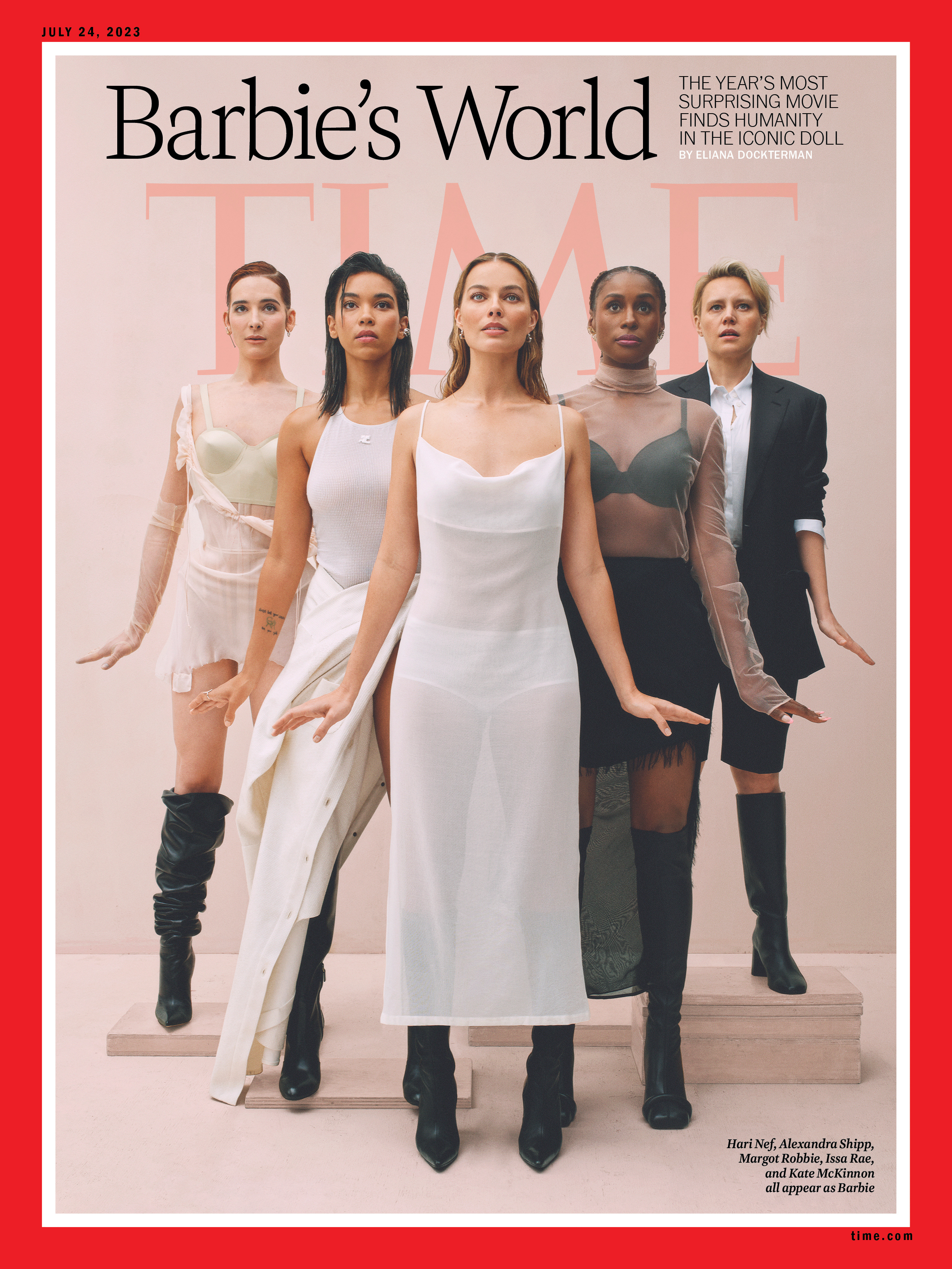
Buy a print of the Barbie’s World cover here
When it was announced in 2021 that Greta Gerwig, who directed the Oscar-nominated coming-of-age stories Lady Bird and Little Women, would helm Barbie, fans were confused, surprised, and delighted. Maybe the movie would be an idiosyncratic, subversive, even feminist take on the doll, not just a commercial for Mattel. But like Barbie, the movie’s existence is an exercise in contradictions.
If you are wondering whether Barbie is a satire of a toy company’s capitalist ambitions, a searing indictment of the current fraught state of gender relations, a heartwarming if occasionally clichéd tribute to girl power, or a musical spectacle filled with earworms from Nicki Minaj and Dua Lipa, the answer is yes. All of the above. And then some.
It’s also the most anticipated movie of the summer—if not the year—which means a lot is riding on Barbie. Not just for Robbie and Gerwig, neither of whom has ever produced a movie on this scale, but also for Mattel. After a period of declining sales, a recently reinvigorated Barbie is ready for her big-screen debut. Barbie’s move to Hollywood is the brainchild of Mattel CEO Ynon Kreiz, who came into the job five years ago with a vision to leverage the company’s intellectual property into a cinematic universe based on Mattel toys.
More from TIME
Barbie will be the proof of concept when it hits theaters on July 21, but first it has to go up against Tom Cruise (Mission: Impossible) and Christopher Nolan (Oppenheimer) in the busiest summer movie season in years. If projections of a $55 million opening weekend prove out, it will be thanks to Barbie mania. Anything associated with the film—a rare blockbuster catering directly to women—has been breathlessly received, from paparazzi photos of Robbie and co-star Ryan Gosling (as Ken) skating down Venice Beach in fluorescent spandex last summer to a teaser that cleverly parodies 2001: A Space Odyssey. Mattel has engineered some of the hype by launching Malibu Barbie cafés and announcing partnerships with Bloomingdale’s, Crocs, and Hot Topic. Other moments suggest a snowball effect: Kim Kardashian recently threw her daughter a Barbie-themed birthday party, and celebs are stepping out in hot pink designer minidresses. (Though, as a Mattel executive reminds me, Barbiecore “didn’t just happen.”)
Whatever audiences ultimately think of Barbie, Gerwig still can’t seem to believe she got away with making this version. “This movie is a goddamn miracle,” she says. She calls it a “surprising spicy margarita.” By the time you realize the salted rim has cayenne mixed in, it’s too late. “You can already taste the sweetness and you sort of go with the spice.”
How did a filmmaker who is best known for thoughtful movies about women’s inner lives come to write and direct a movie about a toy who has no inner life, and is (mostly) defined by her looks? It’s simple: Gerwig loves dolls.
“I played with dolls too long,” says the 39-year-old director. “I was still doing it in junior high. Kids were drinking, and I was playing with dolls.” Gerwig’s mom wasn’t a fan of Barbie for feminist reasons: “She went through the ’60s and was like, ‘What did we do all this for?’” But playing with Barbies proved to be a training ground for Gerwig’s job as a professional storyteller.
Gerwig and her partner, the filmmaker Noah Baumbach, wrote the script under unusual circumstances. After they participated in a Barbie boot camp put on by Mattel, which began with a history lesson on Barbie inventor Ruth Handler and involved a tour of Barbie’s most fabulous (and regrettable) fashions, the pandemic struck. Cloistered in their home in New York, the duo didn’t receive the typical studio notes as they drafted. “We worked hard to give them their space and let them come up with what the movie was going to be, uninterrupted, without people pushing an agenda on them—not Mattel, not Warner Bros., not us,” says Robbie, 32, whose company LuckyChap produced the film. “And then when I saw the script, I was like, ‘They’re never going to let us do this. This is really pushing it.’”
Read More: How Greta Gerwig Is Leading By Example
So, what exactly is this movie? Even with the onslaught of pink-tinged marketing, Warner Bros. has managed to keep the plot under wraps. I’m not here to spoil the film, which I watched in Gerwig’s temporary office, a gray space in Chelsea accessorized with a magenta Barbie doormat. But I can share that it’s a fun yet self-aware romp with shades of Clueless and Legally Blonde. It’s also stuffed full of ideas, and occasionally overwhelmed by them.
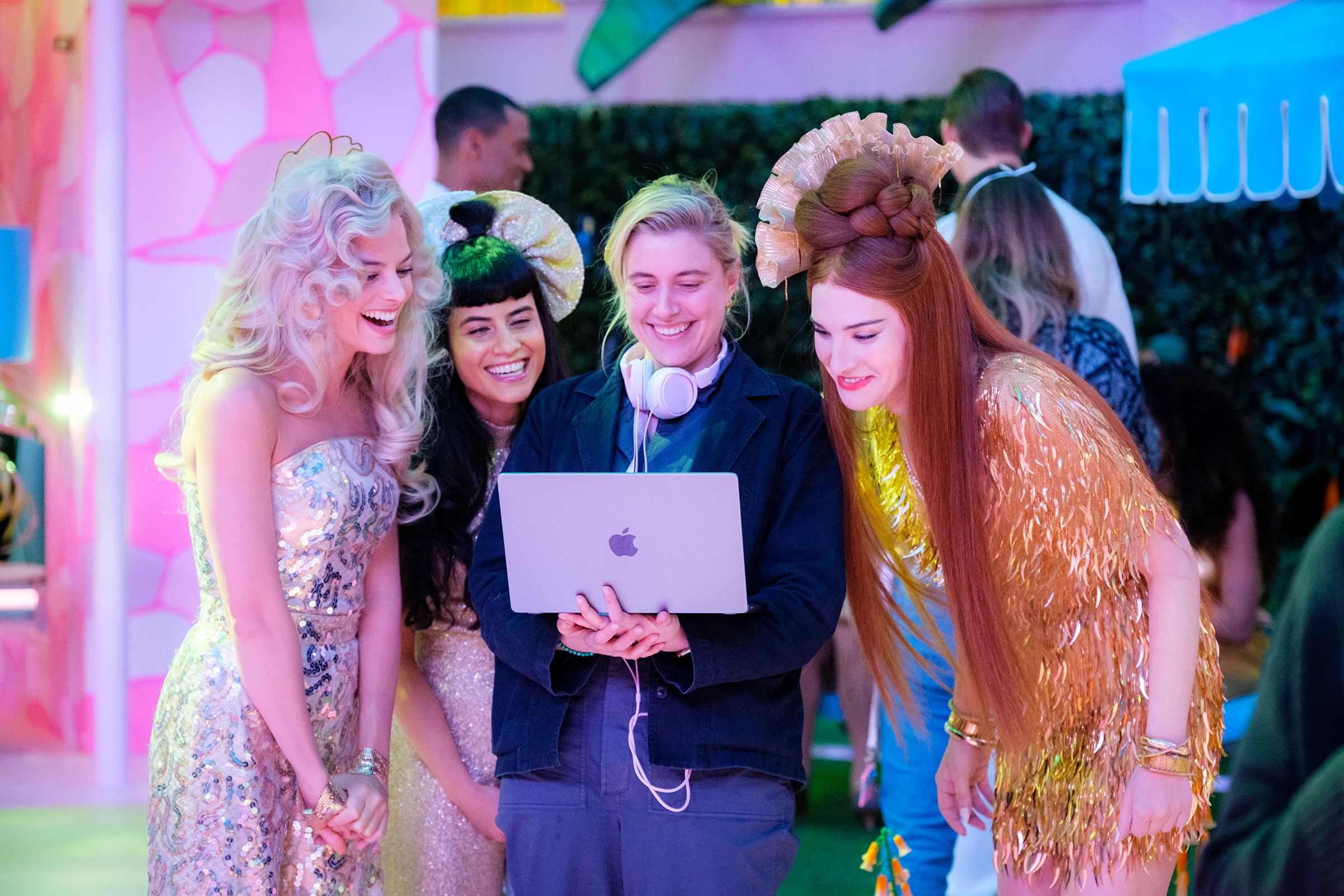
The movie is set in Barbie Land, a utopia where each Barbie has an impressive job. As Helen Mirren’s narrator wryly tells us, “all problems of feminism and equal rights have been solved.” The Barbies have sleepovers every night during which they declare how beautiful and confident they feel. The Kens (played by Gosling and Simu Liu, among others) exist as convenient dance partners. But then Robbie’s Barbie begins to think about mortality. Those arched feet go flat. Cellulite appears on her thigh. To combat these changes, she must venture into the real world with Ken, who has been feeling like a mere accessory in Barbie’s dream life. The real world is, well, real. Men in suits at Mattel—led by Will Ferrell’s CEO—make disingenuous speeches about female empowerment; preteens dress Barbie down for wreaking havoc on their self-esteem. Both Barbie and Ken go on quests of self-discovery, and that’s when things get really interesting. (I won’t give away Ken’s story, but Gosling nearly steals the show.)
There’s also a surprisingly balletic musical number that appears to be inspired by Grease and Singin’ in the Rain; a car-chase sequence; a mysterious woman in a kitchen; and a running gag about Sylvester Stallone’s penchant for mink coats. And that’s all before things turn philosophical.
Every single actor I spoke to cited Gerwig and the sharp script as the reason they joined the film. “I knew this was not going to shy away from the parts of Barbie that are more interesting but potentially a little bit more fraught,” says Hari Nef, who plays a doctor Barbie. “The contemporary history of feminism and body positivity—there are questions of how Barbie can fit into all of that.”
Those points proved more controversial with the corporate entities involved. Robbie Brenner, the first-ever executive producer of Mattel Films and the architect of its cinematic universe, told the company’s top brass, “You’re just gonna white-knuckle it the whole time.”
Gerwig earned the toymaker’s trust with the help of Robbie. At one point Richard Dickson, COO and president of Mattel, says he took a flight to the London set to argue with Gerwig and Robbie over a particular scene, which he felt was off-brand. Dickson dials up his natural boyish exuberance, imitating himself righteously marching off the plane to meet them. But Gerwig and Robbie performed the scene for him and changed his mind. “When you look on the page, the nuance isn’t there, the delivery isn’t there,” explains Robbie.
Read More: Why It Took 64 Years to Make a Barbie Movie
Robbie had laid the groundwork for this with Mattel’s CEO when she met with him in 2018 in the hopes that LuckyChap could take on the Barbie project. “In that very first meeting, we impressed upon Ynon we are going to honor the legacy of your brand, but if we don’t acknowledge certain things—if we don’t say it, someone else is going to say it,” she says. “So you might as well be a part of that conversation.”
Kreiz has hosted several pivotal meetings about Barbie at the Polo Lounge, a see-and-be-seen spot in the Beverly Hills Hotel. It’s where he met Robbie for the first time, and where he invited Brenner to discuss running Mattel’s film division. And so, too, Kreiz invites me, without a hint of irony, to the Polo Lounge to talk about all the other Barbie conversations that took place there. Kreiz was the fourth Mattel CEO in four years when he took over in 2018. He orchestrated a turnaround that included courting Hollywood’s biggest talent with an exacting pitch that has proven to be persuasive. “It’s not about making movies so that we can go and sell more toys,” he says. “We’ve been doing well selling toys without movies.” (The movie does help: the day a Margot Robbie Barbie went on sale, it became the No. 1 doll on Amazon.)
“The most important transition was from being a toy-manufacturing company that was making items to becoming an IP company that is managing franchises,” he says. It’s a particularly prescient strategy at a moment when superhero fatigue has set in and studios are desperate to find new intellectual property with a built-in fan base—from Super Mario Bros. to Dungeons & Dragons. Mattel has announced 14 more movies based on its toys, including a J.J. Abrams–produced Hot Wheels movie and (intriguingly) a Barney film with Daniel Kaluuya. The expansion also includes more streaming shows, video games, and a Mattel theme park currently under construction in Arizona.
From an outdoor table covered in leaves, Kreiz points out the spot where he and Robbie met. The CEO had been as eager to talk with Robbie as she had been to pursue a Barbie film. Before he hired Brenner as executive producer of Mattel Films, he asked who she thought should play the iconic doll. She too said Robbie. “She’s very funny, she’s deep, she’s a fantastic actress, and she does look like …” Brenner pauses. “She’s beautiful.”
It’s obvious why both executives zeroed in on Robbie. She looks like Barbie. Or, as the film says, she looks like “Stereotypical Barbie.” The distinction is important. Just eight years back, in 2015, Barbie’s sales had sunk to $900 million, the lowest in 25 years. So in 2016, Mattel made the biggest change to the doll since she debuted in 1959. In a TIME cover story, I reported on how, after rolling out a wider array of skin tones and hair types for the dolls, Mattel launched three new body types, including Curvy Barbie. It (eventually) worked. Barbie sales rose and hit a record $1.7 billion in 2021 before a small industry-wide slump last year.
Mattel had been toying with the idea of a Barbie movie since 2009. Big stars (Amy Schumer, Anne Hathaway) and prominent directors like Patty Jenkins were rumored to be attached before Robbie met with the company in 2018. One of the reasons Mattel resisted bringing Barbie to the big screen for so long is because the company worked hard to modernize the brand and establish that Barbie is not one body, one personality, one woman. There are currently 175 different Barbies, with different combinations of body shapes, skin tones, and hair types. And yet, here is Margot Robbie on the poster as the manifestation of Barbie. There’s a moment in the film where Mirren makes a tongue-in-cheek joke about Robbie being too beautiful to feel insecure.
Dickson argues that Barbie has to look like Robbie to get audiences who haven’t followed Mattel’s latest updates into theaters. “Of course she looks like Barbie,” he says. “But they’re all Barbie. It’s the perfect cast to express what Barbie is today. And Margot is the bridge.”
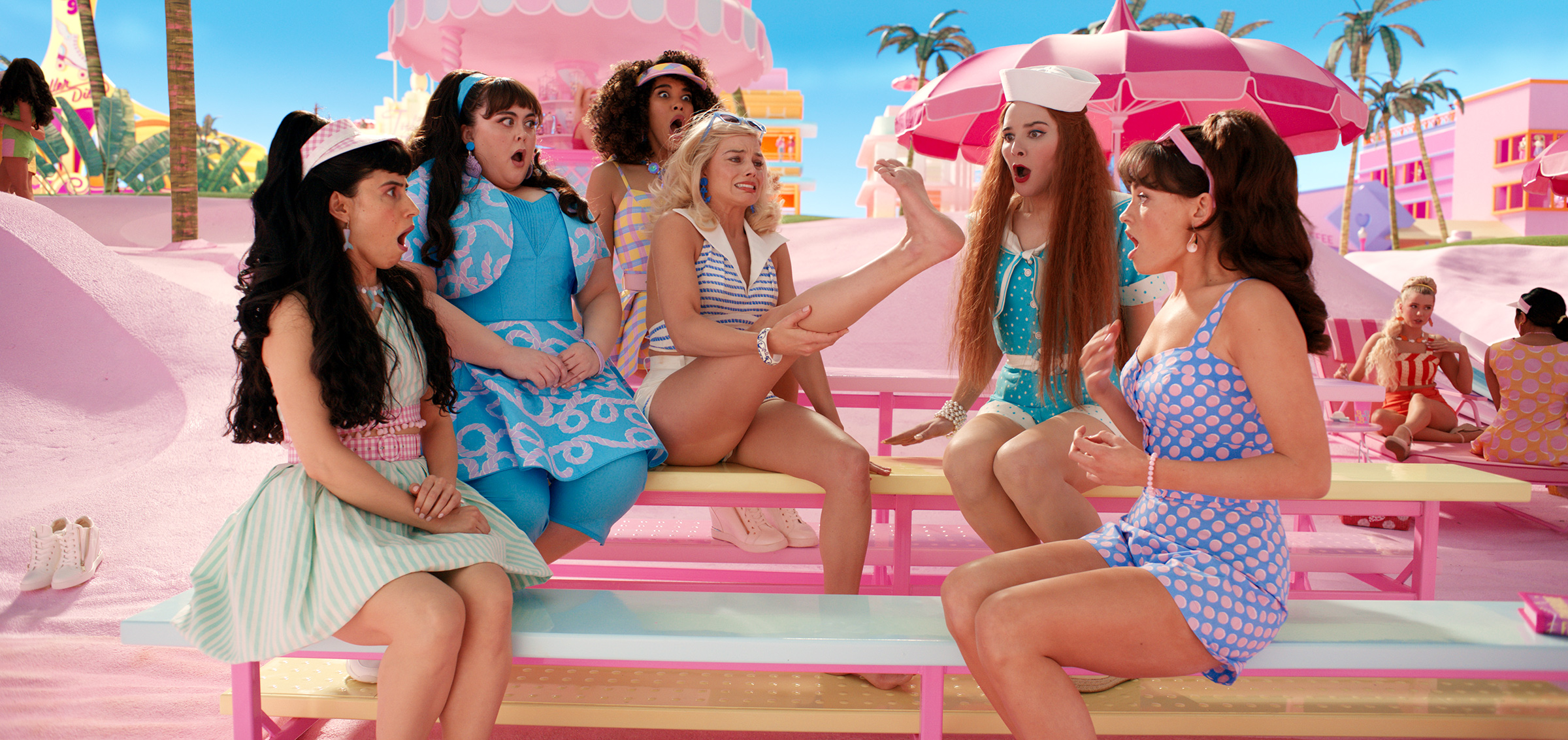
Robbie is flattered that the Mattel execs thought of her, but she would never have wanted to play the only Barbie. “If [Mattel] hadn’t made that change to have a multiplicity of Barbies, I don’t think I would have wanted to attempt to make a Barbie film,” she says. “I don’t think you should say, ‘This is the one version of what Barbie is, and that’s what women should aspire to be and look like and act like.’”
Issa Rae, 38, who plays President Barbie, argues that the entire point of the film is to portray a world in which there isn’t a singular ideal. “My worry was that it was going to feel too white feminist-y, but I think that it’s self-aware,” she says. “Barbie Land is perfect, right? It represents perfection. So if perfection is just a bunch of white Barbies, I don’t know that anybody can get on board with that.”
Read More: What to Know About Midge and Allan, the Deepest Cuts From the Barbie Movie
But it seems Mattel was resistant to appearing too modern. In a recent interview, Amy Schumer revealed that she left her Barbie movie because it wasn’t “feminist and cool,” as she assumes Gerwig’s will be. Dickson, who was in the C-suite at Mattel for other movie discussions, doesn’t comment on Schumer but reflects on past experiences: “It was a matter of finding the right talent that can appreciate the brand’s authenticity and bring that controversy to life in a way that, yes, pokes fun at us but ultimately is purposeful and has heart.”
Still, in an interview for this story, Brenner called Gerwig’s film “not a feminist movie,” a sentiment echoed by other Mattel executives I spoke with. It was a striking contrast to my interpretation of the film and conversations with many of the actors, who used that term unprompted to describe the script. When I relay Mattel’s words to Robbie, she raises an eyebrow. “Who said that?” she asks then sighs. “It’s not that it is or it isn’t. It’s a movie. It’s a movie that’s got so much in it.” The bigger point, Robbie impresses upon me, is “we’re in on the joke. This isn’t a Barbie puff piece.”
Barbie’s Corvette isn’t any old convertible with a slick of pink paint. If you place the doll in her car, it’s too small—the windshield ends at her chest. And so Gerwig insisted the life-size version must be a little small for Robbie. Barbie’s vehicle was carefully created as a model, and scaled up using a mathematical formula to ensure everything in Barbie Land looked “toyetic.”
Read More: How Greta Gerwig Got Barbie—From the Clothes to the Dream House—Just Right
Gerwig’s team built an entire neighborhood made up of Dream Houses that were missing walls. The actors had to be secured by wires so they wouldn’t topple off the second floors. The skies and clouds in the background were hand-painted to render a playroom-like quality, as was much of the rest of the set.
“From a production perspective, it’s bigger than anything we’ve done before,” says Tom Ackerley, 33, Robbie’s producing partner and husband. “We wanted it to feel like you could reach into the screen and touch it.” LuckyChap enlisted David Heyman, who produced the Harry Potter films, to help create this fantastical world. “I don’t think we have seen or will ever see a film with more pink in it,” says Heyman. Gerwig jokingly nicknamed the duo Ken David and Ken Tom.
Not everyone in the film had as robust a relationship with Barbie growing up as Gerwig did. Kate McKinnon preferred to play with shells she found on the beach or small plastic zoo animals. “I didn’t see myself in Barbie when I was younger,” she says. “I saw myself in an inflatable lobster.”
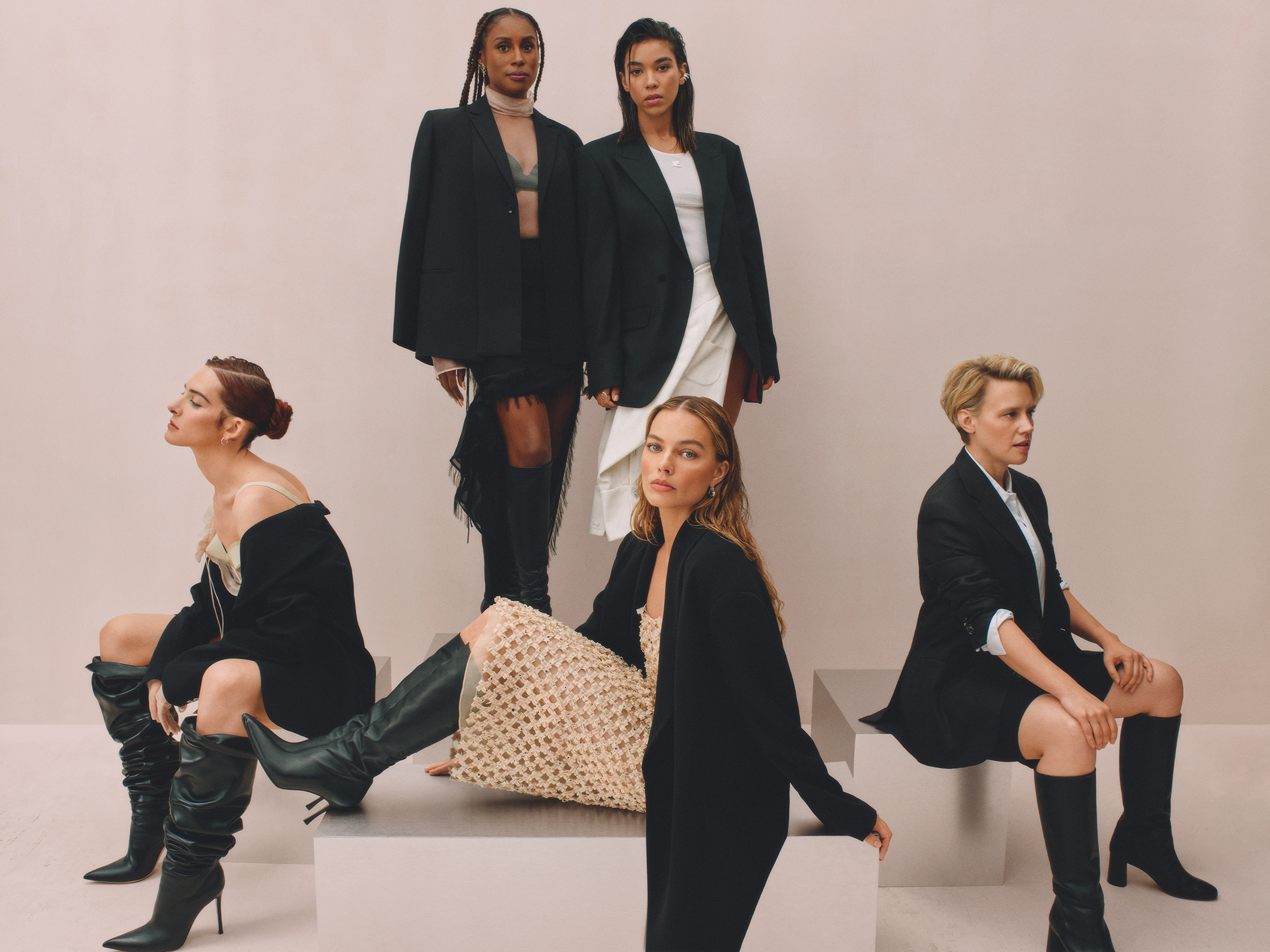
But McKinnon, 39, watched her sister and friends play with the dolls: they cut Barbie’s hair, drew on her face, and even set her on fire. She theorizes, “They were externalizing how they felt, and they felt different.” So when Gerwig offered McKinnon the role of Weird Barbie, a doll that’s been played with a little too aggressively in the real world, she jumped at the chance. McKinnon was impressed by the way the script dealt with girls’ complicated attachments to the doll. “It comments honestly about the positive and negative feelings,” she says. “It’s an incisive cultural critique.”
Alexandra Shipp, who plays an author Barbie, also projected onto the dolls as a child. Shipp, 31, rode on Warner Bros.’ Barbie float in the West Hollywood Pride Parade this year and reflects that Barbie helped her explore aspects of her identity. “When you’re a kid, your toys are an extension of who you are and how you can exist in the world as an adult,” says Shipp. “Sure, I had Kens, but when I played house, I had two Barbies raising a Skipper.”
On social media, Nef, 30, published a letter she wrote to Gerwig and Robbie asking to play one of the Barbies in the film. She says that as a trans woman, she feels ambivalent about the word doll, a slang term in queer culture for trans women, particularly those who celebrate the high femme. The word can feel at once aspirational and oppressive. “It’s a tricky word that holds, for me anyway, such a strict standard created by the patriarchy that deserves to be scrutinized but also a promise of liberation and safety and belonging,” she says. “At the very least, there’s a juicy performance as a doll somewhere in there.”
The world may be obsessed with Barbie’s feet, but Gerwig would like to draw my attention to Barbie’s hands. The director is holed up in New York City putting the final touches on the movie, and she’s eager to dig into its minutiae. The PR team reminds me that our Zoom call is long over, but Gerwig needs a few more minutes to point out that there is a specific image in the film that bears a striking resemblance to Michelangelo’s The Creation of Adam. She starts to point a finger downward, excitedly mimicking the moment in which God bestows life on the first man. Except, in Gerwig’s filmed fresco, Barbie creator Ruth Handler’s hand touches Barbie’s hand.
“It’s on the same trajectory and angle as the Sistine Chapel,” she says. “Nobody is going to notice that so I have to say it.” There’s a lot to unpack in the notion of Handler as God, creating the perfect woman, to be placed in an idyllic matriarchy—and the inevitable chaos that will ensue when Barbie leaves this paradise. But anytime I get too deep into references or the politics of this film with Gerwig or the actors, I’m quickly reminded by an executive or a producer that it’s a fun summer romp.

And it is, in part. It’s a mashup of corporate ambition and personal quirk. Perhaps that’s a triumph in an era when movies about products are en vogue. In the past several months alone we’ve gotten films based on a Nike shoe (Air), an obsolete smartphone (BlackBerry), and a snack (Flamin’ Hot). For Mattel, Barbie is just the beginning. Kreiz enthuses about the possibility of “more Barbie movies.”
Robbie hedges. She’s been involved in conversations, but nothing is set. “It could go a million different directions from this point,” she says. “But I think you fall into a bit of a trap if you try and set up a first movie whilst also planning for sequels.”
It’s hard to imagine a sequel, or any other toy movie for that matter, making the splash that Barbie already has. “We’re looking to create movies that become cultural events,” Kreiz says, and to do that Mattel needs visionaries to produce something more intriguing than a toy ad. “If you can excite filmmakers like Greta and Noah to embrace the opportunity and have creative freedom, you can have a real impact.”
Gerwig herself admits “sometimes these movies can have a quality of hegemonic capitalism” and she had to find ways to make the movie her own. She wove in footage of the cast and crew’s friends and family, including images Robbie has filmed herself on a Super 8 over the years, to give the film a personal touch. It’s a home movie smack-dab in the heart of a summer blockbuster, and Gerwig cries every time she watches that part. “It’s like sneaking in humanity to something that everybody thinks is a hunk of plastic.”
Movement directed by Jamie Neale; fashion edited by Carolina Orrico; set design by James Rene; Nef: styled by Chris Horan, hair by Dhairius Thomas, makeup by Loft Jet; Shipp: styled by Alexandra Mandelkorn, hair by Larry Sims, makeup by Cherish Brooke Hill; Robbie: styled by Andrew Mukamal, hair by Bryce Scarlett, makeup by Nina Park, nails by Tom Bachik; Rae: styled by Wouri Vice, hair by Felicia Leatherwood, makeup by Joanna Simkin; McKinnon: styled by Rebecca Grice, hair by Christine Nelli, makeup by Katey Denno; nails by Natalie Minerva and Vanessa Sanchez McCullough; production by Viewfinders
On the cover: Nef: dress and bra by Maison Martin Margiela, corset by Mr. Pearl, gloves by Elena Velez, earrings by Eera, boots by Gianvito Rossi; Shipp: bodysuit and coat by Courrèges, ring by Lillou, ear cuff by Jennybird, boots by Stuart Weitzman; Robbie: dress, brief, and earrings by Bottega Veneta, boots by Manolo Blahnik; Rae: top, skirt, and boots by Acne Studios; McKinnon: suit by Brioni, shirt by Frame, boots by Loq
More Must-Reads From TIME
- The 100 Most Influential People of 2024
- Coco Gauff Is Playing for Herself Now
- Scenes From Pro-Palestinian Encampments Across U.S. Universities
- 6 Compliments That Land Every Time
- If You're Dating Right Now , You're Brave: Column
- The AI That Could Heal a Divided Internet
- Fallout Is a Brilliant Model for the Future of Video Game Adaptations
- Want Weekly Recs on What to Watch, Read, and More? Sign Up for Worth Your Time
Write to Eliana Dockterman at eliana.dockterman@time.com
